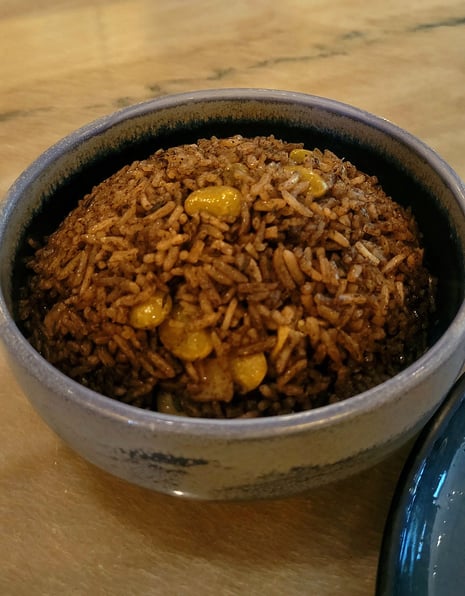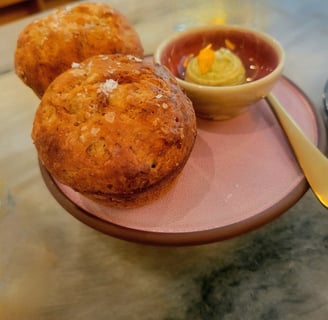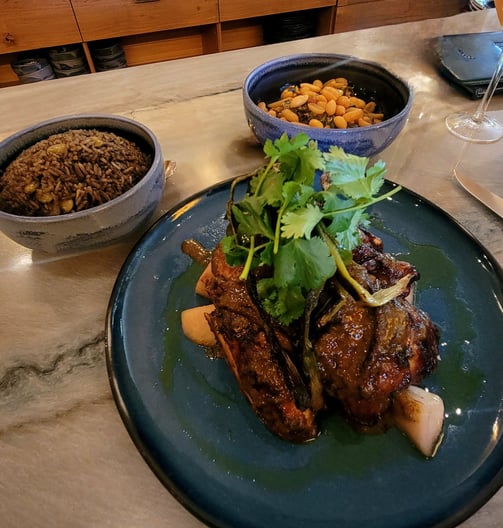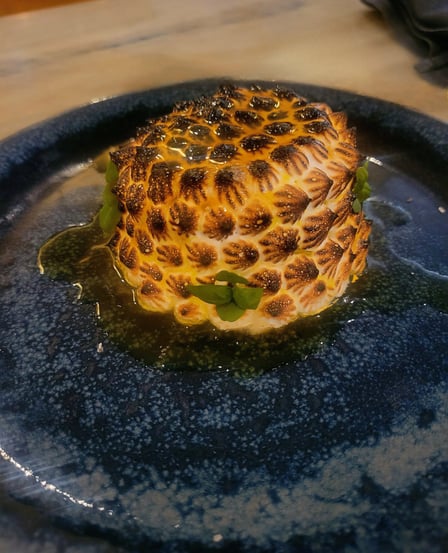
Perception at Kann
At Portland's famous Haitian restaurant, Kann, Caribbean history is folded in coconut cream peaks, piped and charred at the ends.
FOODPERSONAL ESSAYSTRAVEL
Khadjiah Johnson
7/9/20249 min read

Scotch Bonnet provides an audio clip with each piece for accessibility and ease.
By pressing play on the SoundCloud clip below, you can listen as you read along, or just close your eyes and pump it through your listening device!
Thank you for coming on this journey with me!

My partner and I visited Portland, Oregon for our 10-year anniversary trip. On days when the sun breached the peak of the sky, we would find ourselves dashing from eatery to eatery and chasing the sunset along the coastline. Restaurants and food stops, like ScreenDoor, Salt & Straw and Eem Thai brought me so much joy because of their playfulness with flavor. I had iridescent drinks, pear and blue cheese ice cream and the best red curry I ever had. But the main event or rather, the reason why I flew across two time-zones, was to visit Gregory Gourdet's "Kann" A restaurant focused on the uplifting Haitian cuisine and their formidable history.
I knew that when I visited Kann I’d have so much to reflect on. I wanted the story to thread together molasses, burnt sugar, and the Caribbean’s relationship to bitterness rising from the sweet. Before my first bite, I wanted to do a deep dive on what it means to be an Afro-Caribbean American woman. I wanted to speak on how proud of my ancestors I am for fighting in spite of their turmoil and still finding ways to nourish themselves. But by the time the first course hit, the colliding history of racism and the trouble of being an Afro-Caribbean American woman dealing with body image and fatphobia came flooding. Everything I eat affects me. There is no way to ignore the fatphobia and not see the anti-Blackness. There is no way to deal with the history of America and feel the freedom from body perception. This intersectional extravagance exists in whatever plate we consume because of the history attached to everything we eat. So here at Kann, miles away from New York, I learn different ways to reflect and let go in every bite.
On Grains and Gluttony
The relationship to the meat on my bones is a quaking battle. Weight and the perception of my body changes day to day. My journey towards feeling more comfortable with self-image wasn’t found in the success of diet culture, it was seared in the joys of chefs being true to their craft. The best form of respect for my body came from feeding it what my tongue lavishes over. Giving it nutrients, delicious memories, and learning about various cultures along the way. What makes Kann so endearing is its relationship with the revolution and the tongue. Folks without Caribbean ancestry doesn’t truly understand the depth of anti-Blackness and ridicule that Haitian people receive. The island was stripped of their resources, forced to pay reparations for their freedom and to this day in spite of them being the catalyst for the rest of the Caribbean’s rebellion against their colonizers, they’re viewed as an omen.
I ordered the diri ak jon jon. I’ve been fantasizing about it for months. It’s a Haitian savory rice dish where a base of epis seasons Lima beans (and sometimes shellfish), then grains are steeped in a decadent black mushroom stock. When the dish is finished each grain is encased in a faded black tint and those Lima bean gems are soft and bursting with flavor. When I speak of rice, I am often met with ridicule. When I am weighed at the doctor, they assume rice to be the scale tipping culprit before asking about my diet. Yet when I expressed my desire for a hefty bowl of diri ak jon jon, my joy was met with caution. “Why would you want to eat black rice? I don’t know what they did to it. I don’t trust it, sometimes people do evil things to your food.” Anti-blackness blooms along the same crack of the sidewalk as fat-phobia. It latches on from ism to ism. It’s the chaser for marginalization across America. But Blackness in all of its glory is why I’m overjoyed to sit at Kann scooping hills of diri jon jon onto my plate. I want to celebrate mini mountains of savory black rice and the serotonin shot that follows after an umami filled bite. The glory of an island whose cuisine is blessed in spite of a world that tries to wring them dry.


Haiti’s essence is pounded in their epis; Kann infused it into butter and served it on the side with plump plantain buns for my partner and I at the chef’s counter. I pulled one bun to my plate, peered it open with a knife and slicked some epis butter on the inside flap. What I love most about epis is the strong kick you get at the back end of your first bite. Scotch bonnet eludes confidence. In a sauce isn't humble and unassuming. It takes the ingredients it's forced to blend into, and negotiates itself as a power house. A successful slave rebellion costed Haiti their economy; forced to pay reparations to France for their freedom. Lack of funds causes cracks in fundamental necessities like health, housing, education. Haitians suffer from high rates of cardiovascular diseases due to the lack of access to adequate healthcare systems. At Kann, epis is a guide, a peppery reminder for Black American diners that the ocean that separates us can be found on our palates. Colonizers blew the economy in an act of malevolence to keep the growth of Haiti at bay; just like America, who flirts with oblivion, and reflects the same problems onto their Black citizens. Red-lining, major pollutants in low-income areas, underfunded schools. Oh America, master-mind of self-infliction. She who plays with oblivion, while scotch bonnet grows spiteful on the tongue.
Scotch bonnet in epis becomes a flexible fire, turning into a different character depending on what reacts with it. I attribute my high tolerance for spice with my desire to erase. On the days my brain and my body disagreed, I forked down peppers in an attempt to purge the contents from my stomach. When I was in college, I read spicy foods speed up your metabolism. It felt true; evidenced by how quickly it would to send me to the bathroom. Anything I felt mildly guilty for eating, must be followed with a delicacy laced with scotch bonnet. My stomach tumbling never phased me, if my own brain didn’t scrounge my intestines into knots, this would just be another phase to endure. I love spicy food, but I spent too many years viewing scotch bonnet as an excising tool. The epis butter grows along the insides of my mouth. The spice was subtle, but impactful. The grassy heat happily crawled across my palate, and my lips curled up without hesitation. In spite of having plantain all the time, I somehow never had plantain bread nor saw its versatility beyond its original form. So here at Kann where the pepper rises with you in each dish, I invite the spice as a collaborator for nourishment.
On Buns and Blame


On Flesh and Perfectionism
At the distant corner of my eyes, Chef Gourdet spins a plate of pork chops and lightly shuffles the garnish. My partner and I wrestle with who gets the last piece of the plantain bun. A server approaches my partner and I with a dish stacked with various cuts of their spice glazed chicken. I dance in my seat. I parse the thigh through my lips and spread the skin across my tongue. My shoulder detached itself from my chin, I sighed and savored the bites. The warmth, allspice and clove floated in the atmosphere and nestled with a breast on the middle of my tongue. The scent of the charred scallion made a guest appearance, in every bite. When the thigh clashed with the smoked fruit, I pulled in a spoon of the diri jon jon. I focused on anything that would enhance the experience and make it last longer. I scream internally: “So many years of flavor, lost due to the fear of a belly?” For years, I had to find any slight health nut word just to prove to my family the food I was eating won’t make me obese.
In high-school, I was athletic. On the track team, I was a dependable leg in relay races, medaled in shot-put, and for basketball I was my class representative for the three-point shoot-out competition. I spent many days lifting in the gym, doing cardio, but my family’s focus was on me losing weight. I wouldn’t be able to move faster without losing weight. I would look better in dresses if I lost weight. If I was enjoying a plate of food “you need to watch your weight.” I couldn’t expand my palate because fatphobia was met on the other end of the fork. So here at Kann, I say a prayer and remind my body you have traveled far to have a taste of joy. The musk from the smoked fruit incensed the space. We dug our forks and swept up the body with a beat. A chunk of the thigh, breast; sailed to our mouths. We rose our forks and toast the flesh.
The pepper was intoxicating. The Caribbean handles spice with joy. Every bite is a reminder of what can be found in their soil. So much has been stripped of the Caribbean, of Haiti, and yet the world expects the Caribbean to keep giving until they find another source to drain. As climate change persists, the islands are caught in the toils of mother nature’s wrath. When Hurricane Matthew hit Haiti, anti-blackness became the entrée. “This is God cleansing the island of their voodoo.” “There were evil things happening, that’s why they got hit so hard.” “We’re offering thoughts and prayers.” When Haiti became the first successful slave rebellion to achieve independence, the world demonized them. In Racialized Visions: Haiti and the Hispanic Caribbean, Vanessa Valdes speaks of the anti-Blackness aimed at Haiti due to them being symbolically represented as Black power. Black suffering is seen as an anomaly because we are taught to prevail. So, when they indulge in our spices, our sand, sip the water under the canopy of our palm trees, but wish to never take care of the planet that will kill us first, how do you eat at Kann? How do you not reminisce on the accumulated sins of the United States? Of the world powers that seek out Haiti for resources, but deny them asylum at their borders?


Soft Charred Peaks
I was never big on sweets, but I was always reminded that diabetes runs in my family. Usually when I go to dinner, I’m fine with skipping out on dessert, but I was here, on my anniversary dinner with my sweet beloved. Today, I lusted for a light meringue with brown tinted mountain peaks. The Baked Haiti is a light delight. A coconut sponge cake, Bavarian cream, Haitian spiced pineapple, charred meringue and basil. I traded my body consciousness for a trip across the country. At Kann, Caribbean history is folded in coconut cream, piped and charred at the ends.
I was never big on sweets; diabetes runs in my family. My senior year of high school I dropped three dress sizes in two months and no one batted an eye. They asked for my secret, and I met them with lies. Molasses is the slow burn across the back. I derive from Maroons who scattered to the mountains from sugar plantations, but diabetes runs in my family, and my tongue lost its longing for confections. Family jerk recipe, made with burnt sugar. The bitterness is attractive, it masks the problem. Senior year, I had a heartbreak so poetic, I became depressed. I dropped three dress sizes. Bitterness is attractive, it masks the problem. I’m heavier than I ever was, and the other end of the fork no longer terrifies me.
What a blessing now to be swept up in a cloud light bliss that is the Baked Haiti. To let the sweet feather meringue sweep me off my feet, and let the bitterness of the charred mountain tips humble the high. I want to be encased in the layers of the sponge cake and the spiced pineapple. I pray my ancestors found bliss, in the midst of their turmoil. The anti-Blackness doesn’t disappear, but it can’t bother me here at Kann. Gregory Gourdet’s restaurant is a feathered glass forcefield. A necessary place to explore Haiti’s cuisine and reflect on their courageous actions that often goes underappreciated. I am grateful to the chefs for curating an experience that allows visitors to see Haiti’s influence for civil rights during the sugar/spice trade. May Kann remain as a beacon for Haitian cuisine and continue to brighten the region with colorful dishes and bold flavors.


